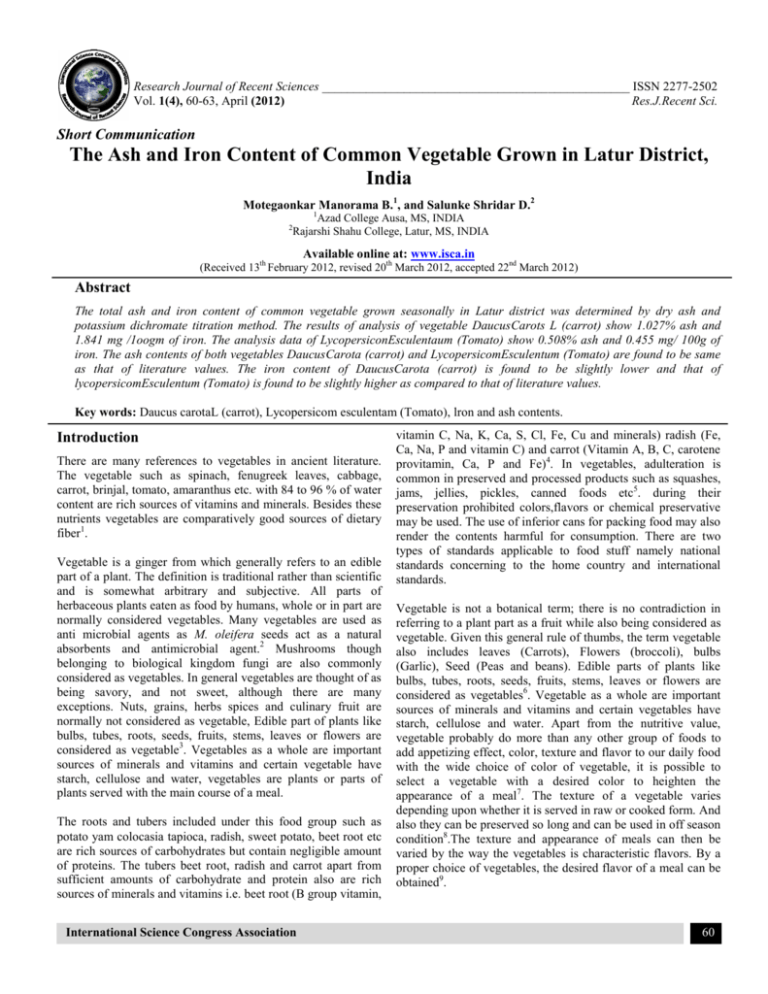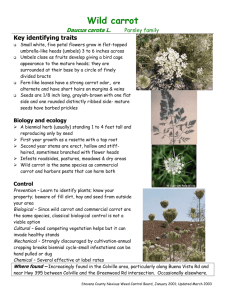The Ash and Iron Content of Common Vegetable Grown in
advertisement

Research Journal of Recent Sciences _________________________________________________ ISSN 2277-2502 Vol. 1(4), 60-63, April (2012) Res.J.Recent Sci. Short Communication The Ash and Iron Content of Common Vegetable Grown in Latur District, India Motegaonkar Manorama B.1, and Salunke Shridar D.2 1 Azad College Ausa, MS, INDIA Rajarshi Shahu College, Latur, MS, INDIA 2 Available online at: www.isca.in (Received 13th February 2012, revised 20th March 2012, accepted 22nd March 2012) Abstract The total ash and iron content of common vegetable grown seasonally in Latur district was determined by dry ash and potassium dichromate titration method. The results of analysis of vegetable DaucusCarots L (carrot) show 1.027% ash and 1.841 mg /1oogm of iron. The analysis data of LycopersiconEsculentaum (Tomato) show 0.508% ash and 0.455 mg/ 100g of iron. The ash contents of both vegetables DaucusCarota (carrot) and LycopersicomEsculentum (Tomato) are found to be same as that of literature values. The iron content of DaucusCarota (carrot) is found to be slightly lower and that of lycopersicomEsculentum (Tomato) is found to be slightly higher as compared to that of literature values. Key words: Daucus carotaL (carrot), Lycopersicom esculentam (Tomato), lron and ash contents. Introduction There are many references to vegetables in ancient literature. The vegetable such as spinach, fenugreek leaves, cabbage, carrot, brinjal, tomato, amaranthus etc. with 84 to 96 % of water content are rich sources of vitamins and minerals. Besides these nutrients vegetables are comparatively good sources of dietary fiber1. Vegetable is a ginger from which generally refers to an edible part of a plant. The definition is traditional rather than scientific and is somewhat arbitrary and subjective. All parts of herbaceous plants eaten as food by humans, whole or in part are normally considered vegetables. Many vegetables are used as anti microbial agents as M. oleifera seeds act as a natural absorbents and antimicrobial agent.2 Mushrooms though belonging to biological kingdom fungi are also commonly considered as vegetables. In general vegetables are thought of as being savory, and not sweet, although there are many exceptions. Nuts, grains, herbs spices and culinary fruit are normally not considered as vegetable, Edible part of plants like bulbs, tubes, roots, seeds, fruits, stems, leaves or flowers are considered as vegetable3. Vegetables as a whole are important sources of minerals and vitamins and certain vegetable have starch, cellulose and water, vegetables are plants or parts of plants served with the main course of a meal. The roots and tubers included under this food group such as potato yam colocasia tapioca, radish, sweet potato, beet root etc are rich sources of carbohydrates but contain negligible amount of proteins. The tubers beet root, radish and carrot apart from sufficient amounts of carbohydrate and protein also are rich sources of minerals and vitamins i.e. beet root (B group vitamin, International Science Congress Association vitamin C, Na, K, Ca, S, Cl, Fe, Cu and minerals) radish (Fe, Ca, Na, P and vitamin C) and carrot (Vitamin A, B, C, carotene provitamin, Ca, P and Fe)4. In vegetables, adulteration is common in preserved and processed products such as squashes, jams, jellies, pickles, canned foods etc5. during their preservation prohibited colors,flavors or chemical preservative may be used. The use of inferior cans for packing food may also render the contents harmful for consumption. There are two types of standards applicable to food stuff namely national standards concerning to the home country and international standards. Vegetable is not a botanical term; there is no contradiction in referring to a plant part as a fruit while also being considered as vegetable. Given this general rule of thumbs, the term vegetable also includes leaves (Carrots), Flowers (broccoli), bulbs (Garlic), Seed (Peas and beans). Edible parts of plants like bulbs, tubes, roots, seeds, fruits, stems, leaves or flowers are considered as vegetables6. Vegetable as a whole are important sources of minerals and vitamins and certain vegetables have starch, cellulose and water. Apart from the nutritive value, vegetable probably do more than any other group of foods to add appetizing effect, color, texture and flavor to our daily food with the wide choice of color of vegetable, it is possible to select a vegetable with a desired color to heighten the appearance of a meal7. The texture of a vegetable varies depending upon whether it is served in raw or cooked form. And also they can be preserved so long and can be used in off season condition8.The texture and appearance of meals can then be varied by the way the vegetables is characteristic flavors. By a proper choice of vegetables, the desired flavor of a meal can be obtained9. 60 Research Journal of Recent Sciences ____________________________________________________________ ISSN 2277-2502 Vol. 1(4), 60-63, April (2012) Res. J. Recent Sci. Vegetable wastes containing high carbohydrates are amenable to anaerobic digestion process and the maximum gas production was observed during 5-10 days of digestion. With nutrition study vegetables are used to study the biogas generation.10 Taking into account significance of vegetables our diet and as a matter of scientific curiosity it is found worthwhile to determine the chemical composition with reference to total mineral content and iron content of DaucusCarota L (carrot) and lucopersicom esculentum (tomato) grown in Latur district. Material and Methods Determination of Ash content: 90 g of DaucusCorota L (corrot) and 120 g of Lycopersicon esculentum (tomato) weighed accurately in a clean silica dish were first heated over a low Bunsen burner flame to volatilize larger part of organic matter and them transferred to a temperature controlled muffle furnace maintained at 3000C. The dry aching is continued till carbon in it has ceased to glow and then the temperature was raised 4500C and the ignitionwe continued for 5 to 7 hours. The standard method11 is used for the ash residue so obtained was then cooled indesiccators and weighted. From the weight of ash residue the percentage of ash was calculated by the formula given below: Percentage of Ash vegetable sample(%) = X100 Determination of Iron Content: 90 gm of DaucusCarota L (carrot) and 120 gm Lycopersicon esculentum (tomato) were accurately weighted in a silica dish and after dry ash 0.5 to 1 g of ash residues were transferred with watch glass the ash residues were moistened 40 to 50 ml of dilute Hydrochloric acid (dil HCl) was added. The contents to heat over hot water both for 30 min subsequently removing the cover and contents to dehydrate silica (SiO2) followed by addition of another 10 ml dilute Hydrochloric acid (dil HCl) and distilled water to dissolve soluble salts. The undissolvedsilica (SiO2) to the breaker was into a 100ml standard flask12. The residual silica particles adhering to breaker were transferred completely to filter funnel. The silicaresidue in the filter funnel was washed for two to three times with hot distilled water and all the wash used filtrate collected in the standard flask were diluted up to mark of 100ml using distilled water. A 25ml of aliquot of above ash solution in the standard flask was pipette out into a clean dry conical flask. The solution was then treated with 1-2 ml of concentrated nitric acid oxidize Fe +2 to Fe +3and made 5 to6 m with respect to hydrochloric acid by adding 10 to 50 ml concentrated hydrochloric acid. The content were heated strongly to 70 to 900C i.e. nearly to boiling and to the hot solution the concentrated tin (II) chloride solution was added drop by drop constant stirring until yellow color of the solution just disappeared ascertaining complete reduction of Fe+3 to Fe+2. Then 1 to 2 drop of tin (II) chloride was added in excess. The content was cooled rapidly under tap water to 20 0 C and excess of tin (II) chloride added was destroyed mercuric chloride solution immediately with vigorous mixing. Then 200 ml of 2.5 % sulphuric acid followed by 5 ml of 85 % phosphoric acid and few drop of 0.2% aqueous solution of sodium Diphenyl amine sulphonate indicator were added. The Fe+2 solutionswere then titrated against 0.01 N potassium dichromate solution till colour assumes bluish green indicating the nearness of the end point. The titration was continued further by adding drop by drop of titrant maintain an interval of few seconds between each addition until addition of one drop caused the formation of intense purple coloration which permanent indicating the end point of titration. Table No. 1 Analytical data for ash and Iron content of common vegetable International Science Congress Association 61 Research Journal of Recent Sciences ____________________________________________________________ ISSN 2277-2502 Vol. 1(4), 60-63, April (2012) Res. J. Recent Sci. Results and Discussion The mineral content in vegetables grown in Latur district was determined by dry ash method. The chemical analysis data for mineral content in vegetables Daucus Carota (carrot) and Lycopersicom esculentum (tomato) grown in Latur district and considered for the present study are given in table-1.The percentage of ash in the vegetable Daucuscarota (carrot) was found to be highest (1.027%). The vegetable Lycopersicon esculentum (tomato) exhibited low percentage of ash (0.508%). The mineral composition in terms of ash, Ca, Mg, Fe, K and P revealed that these traditional vegetables were sufficiently reached in mineral content10 and the amount were much higher than many traditional vegetables of hilly area of this region Out of the two common vegetables considered for investigation the ash percentage of Daucus Carota L (Carrot) is found to be 1.027 % while that of Lycopersicon esculentum (tomato) is found to be 0.508 %. The iron content of DaucusCarota L (carrot) and Lycopersicon esculentum (tomato) is observed as 1.841 and 0.455 mg /100 respectively. The quantitative analysis of vegetable grown in Latur district for their iron content was performed by potassium dichromate titration method. The chemicalanalysis of iron content invegetable daucuscarota (carrot) tomato and show maximum amount of iron (1.841 mg/ 100 gm). The vegetable Lycopersicom esculentum (tomato) Lycopersicon esculentumgrown in Latur District and considered for the present study is given in table 2. The vegetable Daucuscarota (carrot)shows maximum amount of iron (1.84 mg / 100gm). The vegetable Lycopersicom Esculentum (Tomato) is found to have low iron content (0.455 mg/ 100 gm.) Because of the high iron content found in carrot to cure anemiatic problems, this plant was extensively used not only as vegetable but also as medicinal plant for liver and stomach ailments. The amounts of different minerals present in our observed vegetables are equivalent to internationally approved dietary needs to different human categories as milligram per day in different regions of the world. The result obtained are comprised as following graph. Table No. 2 Chemical analysis data for iron (Fe) content in vegetable International Science Congress Association 62 Research Journal of Recent Sciences ____________________________________________________________ ISSN 2277-2502 Vol. 1(4), 60-63, April (2012) Res. J. Recent Sci. Conclusion On the basis of results of analysis of vegetables Daucus Carota L (carrot) and Lycoperesicon esculentum (tomato) for their ash and iron contents, it is revealed that, the ash percentage of both vegetables Daucus Carota L (carrot) and lycopersicon esculentum (tomato) is same as that of their corresponding literature values while the iron content of Daucus Carota L. (carrot) is slightly lower 1.841 (2.20) mg / 100 g and that of Lycopersicom esculentum (tomato) is slightly higher 0.455 (0.40) mg / 100g that of their corresponding literature values shown in parenthesis. From the above discussion it may be concluded that the vegetables Daucus Carota L (Carrot) grown in latur district found to contain rich ash and iron content may be recommended as best curative vegetable for respective mineral deficiency diseases. The results obtained are comprised as following graph. 4. Aberoumand A. and Deokule S.S., Determination of elements profile of some wild edible plants, Food Anal Methods, Doi: 10.1007/s12161-008-9038-z., (2008) 5. Barrett D.M. and Lloyd B., Advanced preservation methods and nutrient retention in fruits and Vegetables, Journal of the Science of Food and Agriculture, 92(1), 7-22 (2011) 6. Gillman S., Protective effect of fruits and vegetables on development of stroke in men, JAMA, 273, 1113. (1995) 7. Gibson R.S., Zinc nutrition in developing countries, Nutr Res Rev.,7, 151–173 (1994) 8. Sun-Waterhouse D., Teoh C. Massarotto A., Wibisono R. and Wadhwa S., Comparative analysis of fruit-based Functional snack bars, Food Chemistry., 119, 1369–1379 (2010) 9. Longvah T., Nutritive value of North-east Indian plant food, Nutr News., 21(1), 1–6 (2000) References 1. 2. 3. Aberoumand A., Nutritional evaluation of edible Portulacaoleracia as plant food, Food Anal Methods, Doi: 10.1007/s12161-008-9049-9 (2008) Mangale S.M., Chonde S.G. and Raut P.D., Use of Moringa Oleifera (Drumstick) seed as Natural Absorbent and an antimicrobial agent for ground water treatment, Res.J.Recent Sci., 1(3), 31-40 (2012) Meyer L.H., Food Chemisty Affiliated East West Press PVT. LTD. New Delhi, East-West students Edition, 3, 4 (1973) International Science Congress Association 10. Dhanalakshmi S.V., Ramanujam R.A, Biogas Generation in a Vegetable Waste Anaerobic Digester, An Analytical Approach, Res.J.Recent Sci.,1(3), 41-47 (2012) 11. AOAC Official methods of analysis of Association of Official Agricultural Chemist, 15th edn, Washington, DC., (1990) 12. Baruah A.M. and Borah R.C., Practical manual on elementary plant biochemistry and chemistry of plant product (PP.4). BNCA, Assam Agricultural University, Chariali, Assam (1998) 63




